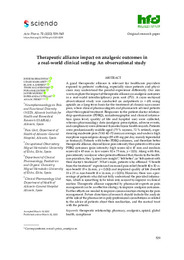Title:
Therapeutic alliance impact on analgesic outcomes in a real-world clinical setting: An observational study |
Authors:
Barrachina, Jordi 
Margarit, César
Andreu, Blanca
Zandonai, Thomas
Ballester, Pura 
Muriel, Javier 
Cutillas, Esperanza 
Peiró, Ana  |
Editor:
Croatian Pharmaceutical Society |
Department:
Departamentos de la UMH::Farmacología, Pediatría y Química Orgánica |
Issue Date:
2022-03-20 |
URI:
https://hdl.handle.net/11000/32346 |
Abstract:
A good therapeutic alliance is relevant for healthcare providers exposed to patients’ suffering, especially since patients and physicians may understand the painful experience differently. Our aim was to explore the impact of therapeutic alliance on analgesic outcomes in a real-world interdisciplinary pain unit (PU). A cross-sectional
observational study was conducted on outpatients (n = 69) using opioids on a long-term basis for the treatment of chronic non-cancer pain, where clinical pharmacologists and pharmacists advised patients about their opioid treatment. Responses to the patient-doctor relationship questionnaire (PDRQ), sociodemographic and clinical information (pain level, quality of life and hospital use) were collected, whereas pharmacology data (analgesic prescription, adverse events, and compliance) were obtained from electronic health records. Patients were predominantly middle-aged (75 % women, 72 % retired), experiencing moderate pain (VAS 40–70 mm) on average, and under a high morphine equianalgesic dosage (95 ± 88 mg per day, mainly tapentadol or fentanyl). Patients with better PDRQ outcomes, and therefore better therapeutic alliance, showed lower pain intensity than patients with worse PDRQ outcomes (pain intensity: high scores 60 ± 47 mm and medium scores 60 ± 45 mm vs. low scores 80 ± 75 mm, p < 0.01). Along with this, pain intensity was lower when patients affirmed that, thanks to the healthcare providers, they “gained new insight”, “felt better”, or “felt content with their doctor’s treatment”. What´s more, patients who affirmed “I benefit from the treatment” experienced increased pain relief (benefit 40 ± 30 vs. non-benefit 19 ± 26 mm, p = 0.010) and improved quality of life (benefit 33 ± 25 vs. non-benefit 18 ± 16 mm, p = 0.031). However, there was a percentage of patients who did not fully understand the provided information, which is something to be taken into account to improve in clinical routine. Therapeutic alliance supported by pharmacist experts on pain management can be an effective strategy to improve analgesic outcomes. Further efforts are needed to improve communication strategies for pain management. Future directions of research should include the analysis of the role of the pharmacist in poly-professional consultations as related to the advice of patients about their medication, and the mutual trust with the patients.
|
Keywords/Subjects:
therapeutic relationship
pharmacy
analgesics
opioid
global health
compliance |
Knowledge area:
CDU: Ciencias aplicadas: Medicina: Farmacología. Terapéutica. Toxicología. Radiología |
Type of document:
info:eu-repo/semantics/article |
Access rights:
info:eu-repo/semantics/openAccess |
DOI:
https://doi.org/10.2478/acph-2022-0035 |
Published in:
Acta pharmaceutica 2022 Oct 18;72(4):529-545 |
Appears in Collections:
Artículos - Farmacología, Pediatría y Química Orgánica
|

.png)
